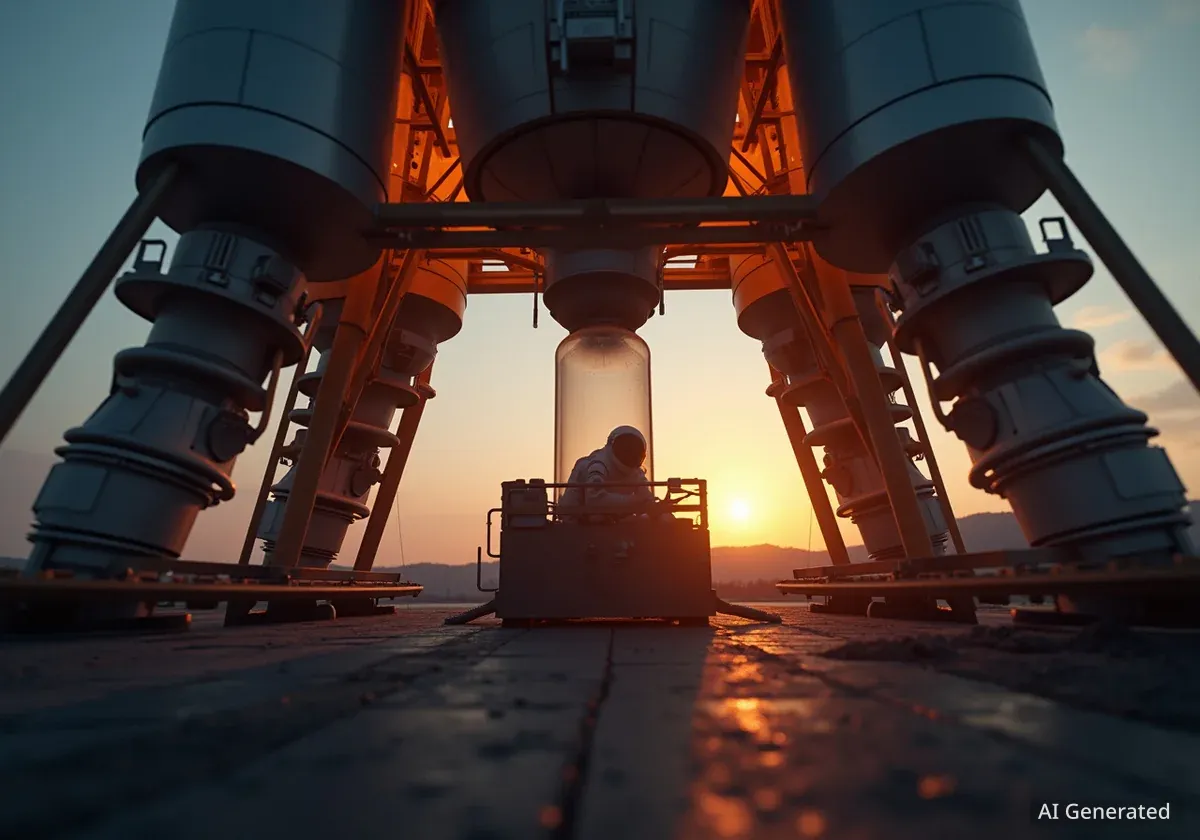The James Webb Space Telescope has provided an exceptionally detailed view of NGC 346, a dynamic star-forming region located in a neighboring galaxy. The new image reveals intricate structures of gas and dust, offering scientists an unprecedented look into the processes that governed star birth in the early universe.
Located approximately 210,000 light-years from Earth in the Small Magellanic Cloud, NGC 346 is one of the most active stellar nurseries in our local cosmic neighborhood. Its chemical composition closely resembles that of galaxies from billions of years ago, making it a crucial laboratory for understanding cosmic history.
Key Takeaways
- The James Webb Space Telescope imaged NGC 346, a star-forming region in the Small Magellanic Cloud.
- The region is about 210,000 light-years away and has a low concentration of heavy elements, similar to the early universe.
- Webb's infrared capabilities allowed it to see through dust clouds to reveal previously hidden protostars and young stars.
- The data helps scientists understand how stars formed during a period known as "cosmic noon," when star birth peaked.
A Glimpse into the Cosmic Past
The Small Magellanic Cloud (SMC), a dwarf galaxy that orbits our own Milky Way, is chemically different from our galactic home. It contains significantly lower concentrations of elements heavier than hydrogen and helium, which astronomers refer to as metals. This low-metallicity environment is very similar to the conditions present in galaxies during the universe's youth.
Studying star formation in the SMC allows researchers to simulate how stars were born during a vibrant era known as "cosmic noon." This period, which occurred roughly 2 to 3 billion years after the Big Bang, was the most prolific star-forming epoch in the universe's history. Understanding the mechanics of star birth in NGC 346 provides a direct window into this fundamental past.
What is Cosmic Noon?
"Cosmic noon" refers to the period in the universe's history when the rate of star formation across all galaxies reached its peak. By studying environments like NGC 346, which mimic the conditions of that era, astronomers can piece together the story of how the first generations of stars and galaxies came to be.
Before the James Webb Space Telescope, studies of NGC 346 were limited. While powerful, other telescopes could not penetrate the dense veils of dust that shroud newborn stars. Webb's advanced infrared instruments have changed the game, allowing scientists to see the building blocks of stars and planets in remarkable detail.
The Technology Behind the Image
To create this stunning image, the science team utilized several of Webb's key instruments. The Near-Infrared Camera (NIRCam) captures light from hotter, more massive stars and reveals the glowing hydrogen gas they energize. The Mid-Infrared Instrument (MIRI) is sensitive to cooler temperatures, allowing it to highlight the emission from cosmic dust and hydrocarbons.
Combining data from these instruments provides a comprehensive view of the region. The wispy, reddish-orange filaments seen in the image are gas and dust being shaped by powerful stellar winds and intense radiation from the most massive young stars at the heart of the cluster. One prominent arc of material, informally dubbed a "dragon" by observers, shows this process in action.
"We are seeing the building blocks, not only of stars, but also potentially of planets," said Guido De Marchi of the European Space Agency, a co-investigator on the research team. "Webb’s ability to probe for low-mass stars is a game changer for our understanding of star-forming regions."
This ability to detect low-mass protostars—stars still in the process of gathering material—is a significant breakthrough. Previous observations primarily identified larger, more mature stars. Webb's sensitivity has unveiled a population of smaller, infant stars for the first time.
Unraveling the Mysteries of Star Formation
Star formation is a complex process. It begins when a dense cloud of gas and dust collapses under its own gravity. As the material clumps together, it heats up, forming a protostar at its core. This protostar continues to accrete gas and dust from a surrounding disk until it becomes hot and dense enough to ignite nuclear fusion, at which point it becomes a true star.
Facts About NGC 346
- Location: Small Magellanic Cloud
- Distance: ~210,000 light-years
- Diameter: Approximately 150 light-years
- Star Count: Contains thousands of stars, including some of the most massive and luminous known.
One of the key questions astronomers are trying to answer is whether the star formation process is different in low-metal environments like the early universe. Metals help cool gas clouds, making it easier for them to collapse and form stars. In theory, star formation should be more difficult in regions like NGC 346.
However, the Webb observations show that even in this metal-poor environment, the region is teeming with activity. The image reveals ribbons of material flowing inward, feeding the central star-forming cluster and fueling the creation of new stars.
The Role of Dust
Cosmic dust plays a critical role in the birth of both stars and planets. The MIRI instrument on Webb is particularly adept at detecting this dust. In the image, blueish patches indicate the presence of complex chemical compounds known as polycyclic aromatic hydrocarbons (PAHs), which are considered building blocks for more complex organic molecules.
According to Olivia C. Jones of the UK Astronomy Technology Centre, the lead researcher on the project, this detailed view provides crucial new information.
"This is the first time we can detect the full sequence of star formation of both low- and high-mass stars in another galaxy," stated Jones. "Since the Small Magellanic Cloud has a similar environment to galaxies during cosmic noon, it’s possible that the rock-and-roll of star formation we see here is representative of what was happening in the early universe."
Future Research and Implications
The data gathered on NGC 346 is just the beginning. The science team, which includes researchers from NASA, the European Space Agency (ESA), and the Canadian Space Agency (CSA), will conduct further analysis using Webb's Near-Infrared Spectrograph (NIRSpec). This instrument will allow them to measure the precise chemical composition of the material around the protostars.
By studying the amount of material these infant stars have accumulated, scientists can determine if the star formation process in the SMC is more or less efficient than what is observed in our own Milky Way. These findings will have profound implications for our models of galaxy evolution and the history of the cosmos.
Ultimately, every star and planet, including our own solar system, was formed from elements forged in previous generations of stars. By looking at NGC 346, the James Webb Space Telescope is not just capturing a beautiful celestial landscape; it is looking back in time to understand our own cosmic origins.





